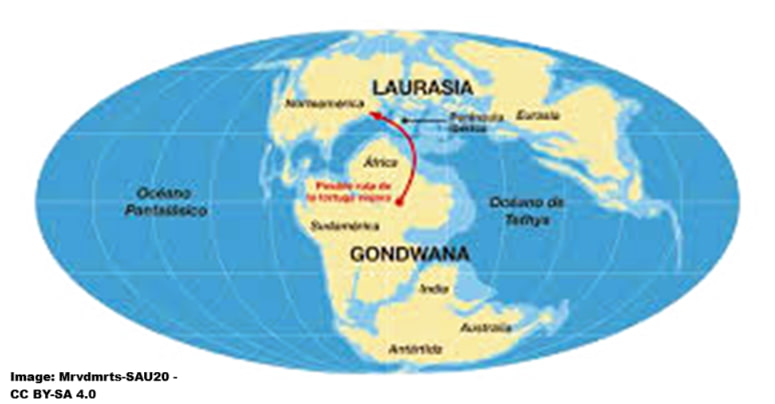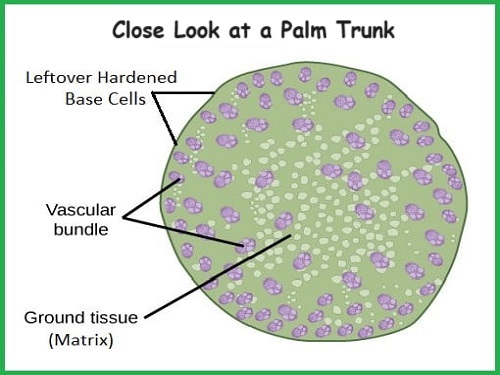- Home
- What are Palms?
- Palm Origins
Origin of Palm Trees -
Ancient Fossils & Prehistoric History
The origin of palm trees takes us on a journey back in time.
Far beyond the realms of written history. Imagine the earth then! It was a very different place, ruled by fearsome dinosaurs.
Some movies give you clues! 🤔 Have you seen the Jurassic Park series?
What if we told you there are inhabitants of that ancient Cretaceous era with us today - standing tall & proud? Would you be surprised that we're talking about the how palms originated? Likely not 😉!
Feeling overwhelmed by so many palm trees?
You're not alone. We Understand your headaches! At Mission: Palm Trees you'll find clear answers to questions & Step-By-Step Guidance, from real people. With solutions to help. No puzzling shoptalk. No tiring research. So it's easy & fun for you.
How Old Are Palm Trees?
The story of the origin of palm trees stretches back millions of years.
Think of a past era when we would hardly recognize the Earth! When it was filled with enormous reptiles. When ferns, cycads, and conifers populated misty prehistoric jungles.
Reaching deep into that Earthly history, we'll see how palms are living fossils.
They're survivors, known to have lived in ecosystems of our planet for about 80-85 million years. We know this, because of the palms' fossil record, dating back to the early part of the Late Cretaceous period.1
Palm Tree Fossil Record & Evolutionary Timeline

Palm trees are some of the earliest flowering plants (angiosperms) to live alongside dinosaurs.
Palms are Monocots, a branch of angiosperms that also includes grasses and lilies. The origin of palm trees demonstrates that they're among the oldest plant families on Earth.
Picture the world during the late Cretaceous period, some 66 to 145 million years ago (Mya - meaning "million years ago." A standard abbreviation used in geology and paleontology to indicate deep time.)
During last part of the Mesozoic Era.
- It was when dinosaurs roamed vast plains.
- It was when ferns and cycads flourished as primary flora.
- It was when flowering plants were only beginning to make their first appearance.
And among them were palms.
Where Did Palm Trees Originate?
You've probably wondered where palm trees first came from.
Scientists have studied ancient fossils and plant DNA to solve this mystery. What they discovered about the origin of palm trees might surprise you!
Palm Trees Started in Cold Places
Palm trees didn't start in tropical beaches like we see them today. Instead, they first appeared in much cooler places!
Several researchers determined there was direct evidence from compelling palm fossils to suggest that palms existed during the Turonian age of the Late Cretaceous Period, about 89-94 Mya.
But generally, it's accepted that the Cretaceous period from 80 million years ago is when the very first palm trees grew in what's now North America, Europe and Asia. Back then, these continents were connected as one big landmass called Laurasia.
Palm trees were among the early flowering plants that were spreading and also developmentally changing in Laurasia.
 Laurasia contained much of the today's continents of North America, Europe and Asia.
Laurasia contained much of the today's continents of North America, Europe and Asia.The Late Cretaceous Origin of Palm Trees
The earliest known palm pollen fossils date to approximately 80-85 million years ago.7 Indicating that palms were already established during the age of dinosaurs.1
By 69 Mya, fossil pollen from Nypa Palms appeared. Then within another 10 million years, palms modified, growing into the many genera we recognize today.
This makes palms an important case study in plant evolution. Showing how flowering plants spread and adapted to worldwide tropical environments.
The Palm Tree Journey South
From their chilly beginnings up north, palm trees slowly spread to warmer places.
Over millions of years, they traveled to South & Central America, Mexico & the U.S. South, Africa, and Southeast Asia, where they're abundant today. Think of it like taking a very, very long vacation to warmer climates and then deciding to stay!
As it seems the earliest palm trees were picky about where they lived, when discovering tropical rainforests. These hot, wet forests gave them everything they needed to grow and do well.
Only much later, some palms learned to live in drier places like deserts.
What This Means for the Origin of Palm Trees Today
Today's palm trees are the descendants of those ancient northern palm trees that made the long journey south.
You can think about its amazing journey from the cold north to the warm tropics - a trip that took millions of years to complete!
Fossil Discoveries in Utah
One of the most intriguing palm fossil discoveries comes from central Utah, in the United States. Not somewhere in a tropical jungle, as we might expect. But in a dry, rocky environment.
In 1970, while hunting a local man stumbled across a strange fossil. The 4-foot specimen looked like a petrified log. As a geology hobbyist, he realized it was very different. Its structure was unusual enough, that he couldn't let it go.
He contacted William Tidwell, a paleobotanist at Brigham Young University.
Tidwell carefully viewed samples under a microscope.
To his amazement, the cell structures matched those of palm trees. That was unexpected!
 No Yearly Growth Rings Here!
No Yearly Growth Rings Here!Image: CNX Open Stax - CC BY 4.0.
Tidwell was astonished and intrigued.
But his colleagues were skeptical about it. They all investigated that Utah site further, to add verification to this find. Together, they found other fossils in the area:
- Additional palm logs preserved in sandstone.
- Flower pollen grains, consistent with palms.
- Twigs? If from palms, more likely They Were Petioles?
Exploring further, Tidwell realized these "twigs" were palm tree roots! Which confirmed the plants truly were palms.
Other remains had already confirmed dinosaur diets included palm fronds.2 It would seem likely that flowers and Fruits of the Palms could also have been food in some dinosaurs’ diets.
Some researchers initially believed the sandstone encasement of the area, where the fossils were found to be as old as 150 million years. That's the Jurassic period. Therefore Tidwell began thinking this discovery "clinched it for us.... Palm trees were growing in these sediments... [showing] flowering plants had established a foothold..." eons before it was thought.3
Early reports jumped on this discovery. For instance the 1970 Time Magazine article called Primeval Palms3 described these findings as evidence that palms were far older than previously thought.
Biologists Scott, Williams, Craig, Barghoorn, Hickey & MacGinitie reported in the American Journal of Botany in 1972 that the fossils could possibly represent “pre-Cretaceous angiosperms.”4 Again, earlier than had been believed.
Scientific Debate Over the Fossil Dating
Later analysis, however, questioned these early claims.
Although later in the reporting article, Scott and colleagues themselves concluded that the Utah palm discoveries were more likely Tertiary (since 2008 called Paleogene and Neogenein age)5, and not Jurassic.
That aligned with mainstream paleobotanical consensus. Which placed the first true palms in the Late Cretaceous era, about 80 Mya.1
The Utah fossils remain an important part of palm research. But they demonstrate how science and paleobotany actually works. Dating plant fossils is complex and is often updated as new evidence emerges.
Why Palm Evolution Matters
Studying palm fossils helps scientists understand not just the history of palms, but also the broader story of flowering plants' evolution. Their rapid expansion during the Cretaceous period provides insight into how:
- Existing plants responded to shifting climates.
- Which flora were a victim of mass extinctions.
- Plant-life reacted with the rise of new ecosystems.
Palms are the prime example highlighting the relentlessness of angiosperms. While many ancient plant families disappeared, palms continued. Diversifying into 2,600+ modern species that today dominate tropical and subtropical landscapes.
Palms vs. Other Ancient Plants
Palms are true flowering plants (the angiosperms). With flowers, fruit, and unique trunk structures that set them apart.
They're unlike ferns, cycads & others which don't reproduce by flowering.
 Flowering Palm Tree
Flowering Palm TreeIt’s easy to confuse palms with cycads or ferns, as their leaves can look quite similar. But their evolutionary paths are very different:
- Cycads: Ancient gymnosperms that predate palms by over 200 million years. They reproduce with cones, not flowers.
- Ferns: Seedless plants that reproduce via spores and dominated prehistoric forests long before palms appeared.
Origin of Palm Trees Timeline
Here's the basic timeline for the origin of palm trees.

Newest Update
-
Backyard Palm Tree Ideas Make Your Space Feel Like a Tropical Escape
Bring a resort feel home. Explore inspiring backyard palm tree ideas with themes like clustering, layering, and lighting designs for any space.
Palms as Witnesses of Earth’s History
The significance of fossils goes beyond a single discovery.
Palms have shown they represent a deeper meaning: their fortitude. Adapting through eons of far-reaching geological and climatic changes. From the age of dinosaurs, through ice ages, to the rise of human civilizations.
Consider what palm trees have lived through:
- The rise and extinction of dinosaurs 🌍
- The dawn of human civilizations 🏺
- The growth and collapse of great empires 👑
- The modern world, where they remain icons of beauty and survival 🌴
 Palms were there, witnessing the dawn of mankind.
Palms were there, witnessing the dawn of mankind. Palms were there when Centurions ruled over their Legionary
Palms were there when Centurions ruled over their LegionaryWhen you see a palm tree today, you're looking at a connection to a world that vanished millions of years ago. We'll be thinking of palms as ancient survivors.
References
1 Harley, (2006). A summary of fossil records for Arecaceae. Botanical Journal of the Linnean Society 151, pp.39–67.
2 Prasad V, Stromberg CAE, Alimohammadian H, Sahni A (2005). Dinosaur coprolites and the early evolution of grasses and grazers. Science 310, pp.1177–1180.
3 Time (1970, Sept. 7). Science: Primeval palms. Retrieved from content.time.com/time/subscriber/article/0,33009,902719,00.html
4 Scott, R., Williams, P., Craig, L., Barghoorn, E., Hickey, L., & MacGinitie, H. (1972). “Pre-Cretaceous” angiosperms from Utah: Evidence for tertiary age of the palm woods and roots. American Journal of Botany. 59. pp.886-896.
5 USGS Communications and Publishing (2016, March 21). EarthWord – Tertiary. USGS - U.S. Geological Survey. Retrieved from usgs.gov/communications-and-publishing/news/earthword-tertiary
6 Reichgelt, T., West, C.K. & Greenwood, D.R. (2018) The relation between global palm distribution and climate. Sci Rep 8, 4721. https://doi.org/10.1038/s41598-018-23147-2
7 Matsunaga, K.K.S. & Smith, S.Y. (2021). Fossil palm reading: using fruits to reveal the deep roots of palm diversity. American Journal of Botany 108(3): 472–494.
8 Greenwood, D.R. & West, C.K. (2017, March 9). A fossil coryphoid palm from the Paleocene of western Canada. Review of Palaeobotany and Palynology, Volume 239, Pages 55-65. https://doi.org/10.1016/j.revpalbo.2016.12.002
9 Couvreur, T.L.B, Forest, F. & Baker, W.J. (2011). Origin and global diversification patterns of tropical rain forests: inferences from a complete genus-level phylogeny of palms. Journal of Biology, 9:44. BMC Biology, at biomedcentral.com/1741-7007/9/44
Key Takeaways for the Origin of Palm Trees
Surviving and adapting through geological epochs, palms have shown amazing resilience
- Palms originated in the Late Cretaceous period, about 80 Mya, alongside dinosaurs.
- Fossil evidence includes pollen, trunks, and roots found worldwide, including Utah.
- Utah fossils sparked debate: once thought to be Jurassic, around 150 Mya, they were later re-dated to the Tertiary period.
- Palms were among the earliest monocot flowering plants to diversify.
- Their success illustrates the rapid spread and resilience of angiosperms.
By studying palm fossils, scientists gain insight into Earth's climate & environmental conditions millions of years ago. Every palm is a bridge between Earth’s prehistoric past and our present moment.
How cool to be amidst a living connection to our Earth's ancient past. And With Our Help, with care and conservation, these remarkable plants will continue their story for generations yet to come.
FAQ for the Origin of Palm Trees
How old are palm trees?
How old are palm trees?
Palms originated around 80 million years ago, During the Early Part of the Late Cretaceous period.
Where were the earliest palm fossils found?
Where were the earliest palm fossils found?
Palm fossils have been found in regions worldwide. From South America, to Africa and even in the so called "New World" of the United States of America and Canada.8
Did palm trees exist with dinosaurs?
Did palm trees exist with dinosaurs?
Yes they did.
Fossil pollen shows palms appeared during the Late Cretaceous geological period, about 80 million years ago. Some Utah Fossils were once thought to be much older, up to 150 million years ago. But later analysis suggested they were younger, as originally thought.
How old are palm trees compared to dinosaurs?
How old are palm trees compared to dinosaurs?
Dinosaurs are older than palm trees. About 150 million years older.
According to the Natural History Museum of London, dinosaurs arose during the late Triassic Period, about 230 million years ago. Multiple dinosaur fossils were discovered in Argentina to verify that.
The fossil evidence for palms now shows they existed as early as 80 million years ago. Making them contemporaries of the dinosaurs, during the Cretaceous period.
Why are palms important today?
Why are palms important today?
Palms have developed more than 2,600+ species, through years and years of evolution.
- Palms provide food (dates, coconuts), materials (raffia, palm oil), important in many cultures.
- They're vital for the healthy ecology in tropical ecosystems.
- Palms provide evidence about Earth’s prehistoric climates.
- Through the ages, Palms Were an Iconic Symbol.
Making them ancient, essential and symbolic.
How are palms different from cycads?
How are palms different from cycads?
Cycads are ancient cone-bearing plants, while palms are flowering plants that produce fruit and have unique vascular structures. See More Detail Above>
What do palm fossils tell us about evolution?
What do palm fossils tell us about evolution?
Palms help scientists piece together ancient climates.
Revealing that palms were among the first flowering plants to diversify and adapt to changing climates.6 Which led to paving the way for modern tropical ecosystems.
Fossil samples show that palms thrived in warm, wet environments. Places that now have cold climates, like Siberia, Colorado & Montana in the US, and Canada.8 The fossil beds allow researchers to reconstruct prehistoric ecosystems and understand how Earth’s climate shifted over time.
That's why palm fossils are valuable to science. They provide more than plant history.






